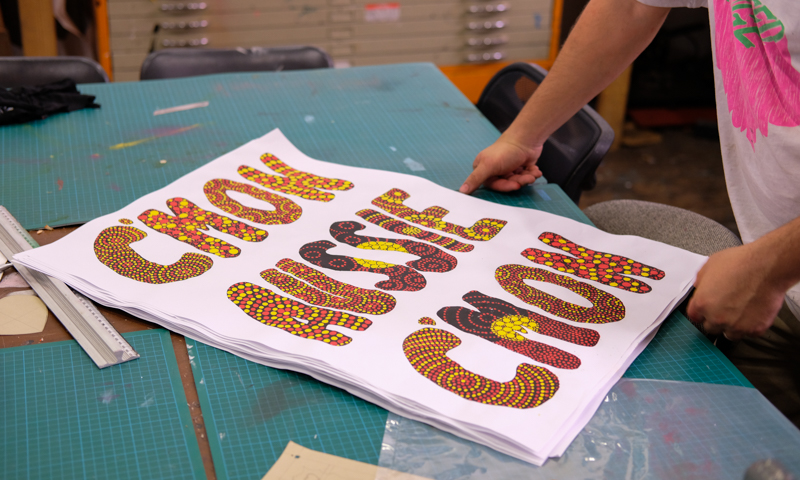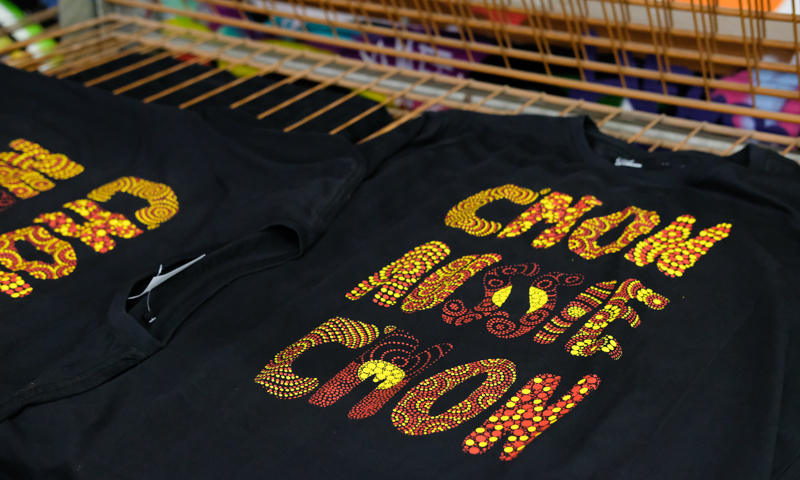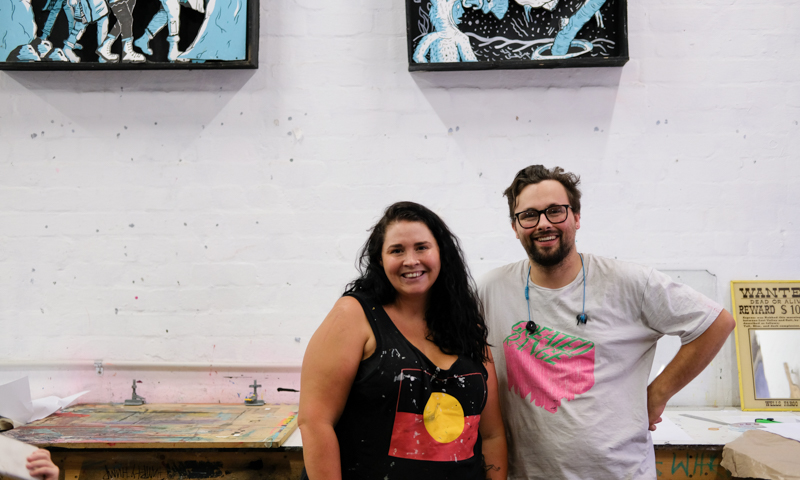After a successful campaign during the same sex marriage plebiscite last year, Jake Holmes has teamed up with Elizabeth Close to reimagine the C’mon Aussie poster for a different cause.
The power of public art
“When I very first started [the C’mon campaign], it was a response to when the US legalised same sex marriage in 2015,” explains screen printer, Jake Holmes.
“I was like ‘Man, that’s crazy that they’ve done it and we haven’t done it,’ and I do political posters, so I wanted to do something commenting on that.”
Elizabeth Close and Jake Holmes will launch the new C’mon Aussie posters on Friday, 26 January at 10:30am on the steps of Parliament House.
Elders Uncle Major ‘Moogy’ Sumner, Tauto Sansbury, Allen Edwards, FUSA Indigenous Officer Yaritji Green, and Greens MLC Tammy Franks will speak at the event. For more information, see here.
The rainbow posters Jake designed, now so familiar on the streets of Adelaide, were never meant to be so widespread.
“I made a few, like 15 paste-ups, with my girlfriend, we just made them one night and went out and stuck them up around the city, and I was like ‘Cool,’ that’s all I was thinking,” Jake says.
“Then I was chatting with my mate Peter [Drew], who did the Real Australians Say Welcome project, and he showed me how he did his campaigns for that, where you sell posters, and then that allows you to make a bunch of posters for free, and so we teamed up to help with that.”
Jake held onto the cache of funds raised until the plebiscite was announced, and saw a practical use for the posters.
“I expected I’d send a few around Adelaide and a few interstate, but around the time of the plebiscite, it just exploded, and I think it ended up being around 1,200 posters. The National Gallery asked for one, a few different collections have asked for them,” Jake says.
Adelaide Indigenous street artist, Elizabeth Close, recognised the power of the campaign and was looking for a way to lend her artwork with the Change the Date debate.
“Coming up to this year, the momentum has never been bigger. Every year this movement is getting bigger and bigger and bigger, I was like ‘I have to do something. What can I do?’ And really, all I can do is paint, or use that kind of medium to make a statement,” Elizabeth says.
“I hit up Jake to have a chat… and so we got chatting about his campaign, because I think it was really very cleverly done in how subversive that message was, how it kind of got into your consciousness before you even knew it.”
The two decided to re-imagine the C’mon poster, the lettering now filled with Elizabeth’s dot painting design.
Jake admits that the aim of the posters is not necessarily to change the minds of detractors, but to galvanise those who believe in the cause, and maybe trigger people who haven’t given much thought to the Change the Date debate to form an opinion.
This is particularly important, Elizabeth says, at a time when, according to Reconciliation Australia, only 30 per cent of the general community socialises with Aboriginal and Torres Strait Islander people.
“If you never speak to someone who’s Aboriginal, and you never interact with them, and you’re never in the same forums or on the same Facebook pages, you’re never going to see the rationale and the thought process behind why we say what we do, why we do what we do, and so I think that’s very important,” she says.
Although the artists will be launching the posters this Friday, 26 January on the steps of Parliament House, Elizabeth emphasises that her main hope with the campaign is not necessarily to change the date. Instead, “it’s just about listening and respect,” she says.
“Basically all systems of government need to sit and actually meaningfully listen to what Aboriginal people have to say, even if it’s uncomfortable, and even if it’s difficult to hear, and even if it’s challenging.
“I think that this poster, launching this poster, using this poster as a call to action is important, and I think it does just that, but what it really is about, is… sitting and listening to Aboriginal people, what they want at a community level, so that we can start to move forward.”
Jake and Elizabeth acknowledge that fundraising for this campaign might not be the right approach, and will consult with the Indigenous community before going further, but they do plan to make the posters available to the public in some form.
“If people like the image and are wanting to use it as a way to rally behind these issues that we’re talking about, then we’ll provide it in some way,” Jake says.
“Whether that’s through a similar campaign to raise money, or whether it’s just going ‘Here’s a high-res PDF, download these and print them out yourselves.’”






